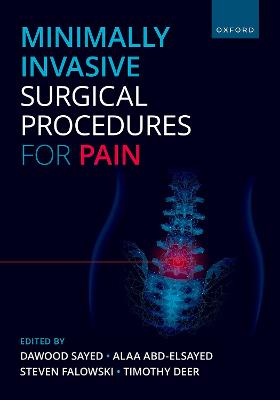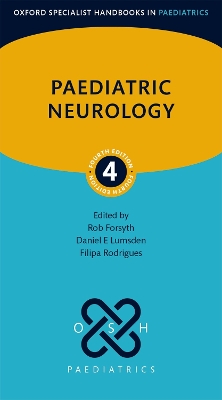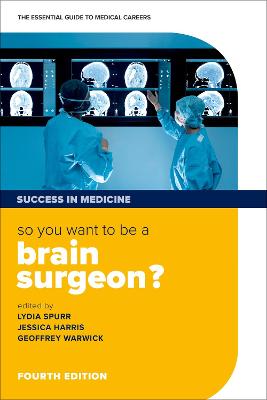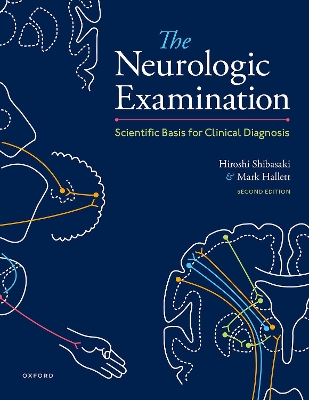Clinical Neurophysiology
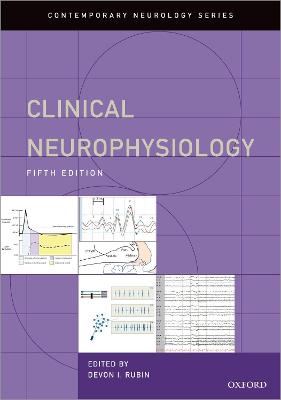 -10%
portes grátis
-10%
portes grátis
Clinical Neurophysiology
Rubin, Devon I.
Oxford University Press Inc
10/2021
1128
Dura
Inglês
9780190067854
15 a 20 dias
2836
Descrição não disponível.
BASIC NEUROPHYSIOLOGY
Chapter 1. Basics of Neurophysiology (Potentials, synaptic transmission, muscle physiology)
Chapter 2. Electrophysiologic Generators in Clinical Neurophysiology
Chapter 3. Waveforms and Artifacts
CLINICAL ELECTROENCEPHALOGRAPHY
Adult EEG
Chapter 4. Adult EEG - Normal and Benign Variants
Chapter 5. Adult EEG - Artifacts
Chapter 6. Adult EEG - Epileptiform Activity
Chapter 7. Adult EEG - Abnormal Non-epileptiform Activity and Brain Death
Pediatric EEG
Chapter 8. Pediatric EEG - Normal Maturational Changes
Chapter 9. Pediatric EEG - Epileptiform Activity
EEG - Special Studies and Surgical Monitoring
Chapter 10. Long Term, Computer Assisted Ambulatory EEG Recording
Chapter 11. Long Term Video EEG Recording in Epilepsy Monitoring Unit
Chapter 12. EEG Trend Analysis in the ICU
Chapter 13. Intracranial Monitoring and Electrocorticography (Nasopharyngeal, Sphenoidal. Depth, Subdural electrodes)
Chapter 14. Quantitative EEG Analysis, EEG Mapping, and Magnetoencephalography
Applications
Chapter 15. Assessment of Spells and Seizure in the Outpatient Setting
Chapter 16. Epilepsy Surgery Evaluation
CLINICAL ELECTROMYOGRAPHY
Nerve Conduction Studies
Chapter 17. Motor Nerve Conduction Studies
Chapter 18. Sensory Nerve Conduction Studies
Chapter 19. Late Responses: F waves and H reflexes
Chapter 20. Repetitive Nerve Stimulation Studies
Chapter 21. Cranial Nerve Studies
Chapter 22. Quantitative Motor Unit Number Estimates
Chapter 23. Technical Issues and Potential Complications of Nerve Conduction Studies
Needle Electromyography
Chapter 24. Needle Electromyography
Chapter 25. Quantitative Electromyography
Chapter 26. Single Fiber Electromyography
Chapter 27. Pitfalls and Potential Complications of Needle EMG
Applications of Electromyography
Chapter 28. Assessment of Mononeuropathies
Chapter 29. Assessment of Radiculopathies
Chapter 30. Assessment of Plexopathies
Chapter 31. Assessment of Polyneuropathies
Chapter 32. Assessment of Motor Neuron Diseases
Chapter 33. Assessment of Neuromuscular Junction Diseases
Chapter 34. Assessment of Myopathies
Chapter 35. Neuromuscular ICU Testing
Chapter 36. Neuromuscular Ultrasound in the EMG Lab
EVOKED POTENTIALS
Chapter 37. Somatosensory Evoked Potentials
Chapter 38. Visual Evoked Potentials
Chapter 39. Brainstem Auditory Evoked Potentials
Chapter 40. Motor Evoked Potentials
ASSESSMENT OF AUTONOMIC FUNCTION
Chapter 41. Autonomic Physiology
Chapter 42. Quantitative Sudomotor Axon Reflex and Related Tests
Chapter 43. Evaluation of Adrenergic Function
Chapter 44. Thermoregulatory Sweat Test
Chapter 45. Cardiovagal Reflexes
CLINICAL NEUROPHYSIOLOGY OF MOVEMENT DISORDERS
Chapter 46. Movement-Related Potentials and Event-Related Potentials
Chapter 47. Long Latency Reflexes and the Silent Period
Chapter 48. Electrophysiology of Movement Disorders
ASSESSMENT OF SLEEP
Chapter 49. Assessment of Sleep and Sleep Disorders: Polysomnography and Other Tests
Chapter 50. Pediatric Sleep Assessment
Chapter 51. Abnormal Sleep and Sleep Disorders
INTRAOPERATIVE MONITORING
Chapter 52. Cerebral Function Monitoring and Cortical Mapping for Non-epilepsy surgery
Chapter 53. Brain Stem and Cranial Nerve Monitoring
Chapter 54. Spinal Cord Monitoring
Chapter 55. Peripheral Nervous System Monitoring
ELECTRICAL CONCEPTS AND SAFETY
Chapter 56. Electricity and Instrumentation in Clinical Neurophysiology (including electrodes, amplifiers, stimulators)
Chapter 57. Volume Conduction
Chapter 58. Digital Signal Processing
Chapter 59. Electrical Safety in the Neurophysiology Laboratory
Chapter 1. Basics of Neurophysiology (Potentials, synaptic transmission, muscle physiology)
Chapter 2. Electrophysiologic Generators in Clinical Neurophysiology
Chapter 3. Waveforms and Artifacts
CLINICAL ELECTROENCEPHALOGRAPHY
Adult EEG
Chapter 4. Adult EEG - Normal and Benign Variants
Chapter 5. Adult EEG - Artifacts
Chapter 6. Adult EEG - Epileptiform Activity
Chapter 7. Adult EEG - Abnormal Non-epileptiform Activity and Brain Death
Pediatric EEG
Chapter 8. Pediatric EEG - Normal Maturational Changes
Chapter 9. Pediatric EEG - Epileptiform Activity
EEG - Special Studies and Surgical Monitoring
Chapter 10. Long Term, Computer Assisted Ambulatory EEG Recording
Chapter 11. Long Term Video EEG Recording in Epilepsy Monitoring Unit
Chapter 12. EEG Trend Analysis in the ICU
Chapter 13. Intracranial Monitoring and Electrocorticography (Nasopharyngeal, Sphenoidal. Depth, Subdural electrodes)
Chapter 14. Quantitative EEG Analysis, EEG Mapping, and Magnetoencephalography
Applications
Chapter 15. Assessment of Spells and Seizure in the Outpatient Setting
Chapter 16. Epilepsy Surgery Evaluation
CLINICAL ELECTROMYOGRAPHY
Nerve Conduction Studies
Chapter 17. Motor Nerve Conduction Studies
Chapter 18. Sensory Nerve Conduction Studies
Chapter 19. Late Responses: F waves and H reflexes
Chapter 20. Repetitive Nerve Stimulation Studies
Chapter 21. Cranial Nerve Studies
Chapter 22. Quantitative Motor Unit Number Estimates
Chapter 23. Technical Issues and Potential Complications of Nerve Conduction Studies
Needle Electromyography
Chapter 24. Needle Electromyography
Chapter 25. Quantitative Electromyography
Chapter 26. Single Fiber Electromyography
Chapter 27. Pitfalls and Potential Complications of Needle EMG
Applications of Electromyography
Chapter 28. Assessment of Mononeuropathies
Chapter 29. Assessment of Radiculopathies
Chapter 30. Assessment of Plexopathies
Chapter 31. Assessment of Polyneuropathies
Chapter 32. Assessment of Motor Neuron Diseases
Chapter 33. Assessment of Neuromuscular Junction Diseases
Chapter 34. Assessment of Myopathies
Chapter 35. Neuromuscular ICU Testing
Chapter 36. Neuromuscular Ultrasound in the EMG Lab
EVOKED POTENTIALS
Chapter 37. Somatosensory Evoked Potentials
Chapter 38. Visual Evoked Potentials
Chapter 39. Brainstem Auditory Evoked Potentials
Chapter 40. Motor Evoked Potentials
ASSESSMENT OF AUTONOMIC FUNCTION
Chapter 41. Autonomic Physiology
Chapter 42. Quantitative Sudomotor Axon Reflex and Related Tests
Chapter 43. Evaluation of Adrenergic Function
Chapter 44. Thermoregulatory Sweat Test
Chapter 45. Cardiovagal Reflexes
CLINICAL NEUROPHYSIOLOGY OF MOVEMENT DISORDERS
Chapter 46. Movement-Related Potentials and Event-Related Potentials
Chapter 47. Long Latency Reflexes and the Silent Period
Chapter 48. Electrophysiology of Movement Disorders
ASSESSMENT OF SLEEP
Chapter 49. Assessment of Sleep and Sleep Disorders: Polysomnography and Other Tests
Chapter 50. Pediatric Sleep Assessment
Chapter 51. Abnormal Sleep and Sleep Disorders
INTRAOPERATIVE MONITORING
Chapter 52. Cerebral Function Monitoring and Cortical Mapping for Non-epilepsy surgery
Chapter 53. Brain Stem and Cranial Nerve Monitoring
Chapter 54. Spinal Cord Monitoring
Chapter 55. Peripheral Nervous System Monitoring
ELECTRICAL CONCEPTS AND SAFETY
Chapter 56. Electricity and Instrumentation in Clinical Neurophysiology (including electrodes, amplifiers, stimulators)
Chapter 57. Volume Conduction
Chapter 58. Digital Signal Processing
Chapter 59. Electrical Safety in the Neurophysiology Laboratory
Este título pertence ao(s) assunto(s) indicados(s). Para ver outros títulos clique no assunto desejado.
BASIC NEUROPHYSIOLOGY
Chapter 1. Basics of Neurophysiology (Potentials, synaptic transmission, muscle physiology)
Chapter 2. Electrophysiologic Generators in Clinical Neurophysiology
Chapter 3. Waveforms and Artifacts
CLINICAL ELECTROENCEPHALOGRAPHY
Adult EEG
Chapter 4. Adult EEG - Normal and Benign Variants
Chapter 5. Adult EEG - Artifacts
Chapter 6. Adult EEG - Epileptiform Activity
Chapter 7. Adult EEG - Abnormal Non-epileptiform Activity and Brain Death
Pediatric EEG
Chapter 8. Pediatric EEG - Normal Maturational Changes
Chapter 9. Pediatric EEG - Epileptiform Activity
EEG - Special Studies and Surgical Monitoring
Chapter 10. Long Term, Computer Assisted Ambulatory EEG Recording
Chapter 11. Long Term Video EEG Recording in Epilepsy Monitoring Unit
Chapter 12. EEG Trend Analysis in the ICU
Chapter 13. Intracranial Monitoring and Electrocorticography (Nasopharyngeal, Sphenoidal. Depth, Subdural electrodes)
Chapter 14. Quantitative EEG Analysis, EEG Mapping, and Magnetoencephalography
Applications
Chapter 15. Assessment of Spells and Seizure in the Outpatient Setting
Chapter 16. Epilepsy Surgery Evaluation
CLINICAL ELECTROMYOGRAPHY
Nerve Conduction Studies
Chapter 17. Motor Nerve Conduction Studies
Chapter 18. Sensory Nerve Conduction Studies
Chapter 19. Late Responses: F waves and H reflexes
Chapter 20. Repetitive Nerve Stimulation Studies
Chapter 21. Cranial Nerve Studies
Chapter 22. Quantitative Motor Unit Number Estimates
Chapter 23. Technical Issues and Potential Complications of Nerve Conduction Studies
Needle Electromyography
Chapter 24. Needle Electromyography
Chapter 25. Quantitative Electromyography
Chapter 26. Single Fiber Electromyography
Chapter 27. Pitfalls and Potential Complications of Needle EMG
Applications of Electromyography
Chapter 28. Assessment of Mononeuropathies
Chapter 29. Assessment of Radiculopathies
Chapter 30. Assessment of Plexopathies
Chapter 31. Assessment of Polyneuropathies
Chapter 32. Assessment of Motor Neuron Diseases
Chapter 33. Assessment of Neuromuscular Junction Diseases
Chapter 34. Assessment of Myopathies
Chapter 35. Neuromuscular ICU Testing
Chapter 36. Neuromuscular Ultrasound in the EMG Lab
EVOKED POTENTIALS
Chapter 37. Somatosensory Evoked Potentials
Chapter 38. Visual Evoked Potentials
Chapter 39. Brainstem Auditory Evoked Potentials
Chapter 40. Motor Evoked Potentials
ASSESSMENT OF AUTONOMIC FUNCTION
Chapter 41. Autonomic Physiology
Chapter 42. Quantitative Sudomotor Axon Reflex and Related Tests
Chapter 43. Evaluation of Adrenergic Function
Chapter 44. Thermoregulatory Sweat Test
Chapter 45. Cardiovagal Reflexes
CLINICAL NEUROPHYSIOLOGY OF MOVEMENT DISORDERS
Chapter 46. Movement-Related Potentials and Event-Related Potentials
Chapter 47. Long Latency Reflexes and the Silent Period
Chapter 48. Electrophysiology of Movement Disorders
ASSESSMENT OF SLEEP
Chapter 49. Assessment of Sleep and Sleep Disorders: Polysomnography and Other Tests
Chapter 50. Pediatric Sleep Assessment
Chapter 51. Abnormal Sleep and Sleep Disorders
INTRAOPERATIVE MONITORING
Chapter 52. Cerebral Function Monitoring and Cortical Mapping for Non-epilepsy surgery
Chapter 53. Brain Stem and Cranial Nerve Monitoring
Chapter 54. Spinal Cord Monitoring
Chapter 55. Peripheral Nervous System Monitoring
ELECTRICAL CONCEPTS AND SAFETY
Chapter 56. Electricity and Instrumentation in Clinical Neurophysiology (including electrodes, amplifiers, stimulators)
Chapter 57. Volume Conduction
Chapter 58. Digital Signal Processing
Chapter 59. Electrical Safety in the Neurophysiology Laboratory
Chapter 1. Basics of Neurophysiology (Potentials, synaptic transmission, muscle physiology)
Chapter 2. Electrophysiologic Generators in Clinical Neurophysiology
Chapter 3. Waveforms and Artifacts
CLINICAL ELECTROENCEPHALOGRAPHY
Adult EEG
Chapter 4. Adult EEG - Normal and Benign Variants
Chapter 5. Adult EEG - Artifacts
Chapter 6. Adult EEG - Epileptiform Activity
Chapter 7. Adult EEG - Abnormal Non-epileptiform Activity and Brain Death
Pediatric EEG
Chapter 8. Pediatric EEG - Normal Maturational Changes
Chapter 9. Pediatric EEG - Epileptiform Activity
EEG - Special Studies and Surgical Monitoring
Chapter 10. Long Term, Computer Assisted Ambulatory EEG Recording
Chapter 11. Long Term Video EEG Recording in Epilepsy Monitoring Unit
Chapter 12. EEG Trend Analysis in the ICU
Chapter 13. Intracranial Monitoring and Electrocorticography (Nasopharyngeal, Sphenoidal. Depth, Subdural electrodes)
Chapter 14. Quantitative EEG Analysis, EEG Mapping, and Magnetoencephalography
Applications
Chapter 15. Assessment of Spells and Seizure in the Outpatient Setting
Chapter 16. Epilepsy Surgery Evaluation
CLINICAL ELECTROMYOGRAPHY
Nerve Conduction Studies
Chapter 17. Motor Nerve Conduction Studies
Chapter 18. Sensory Nerve Conduction Studies
Chapter 19. Late Responses: F waves and H reflexes
Chapter 20. Repetitive Nerve Stimulation Studies
Chapter 21. Cranial Nerve Studies
Chapter 22. Quantitative Motor Unit Number Estimates
Chapter 23. Technical Issues and Potential Complications of Nerve Conduction Studies
Needle Electromyography
Chapter 24. Needle Electromyography
Chapter 25. Quantitative Electromyography
Chapter 26. Single Fiber Electromyography
Chapter 27. Pitfalls and Potential Complications of Needle EMG
Applications of Electromyography
Chapter 28. Assessment of Mononeuropathies
Chapter 29. Assessment of Radiculopathies
Chapter 30. Assessment of Plexopathies
Chapter 31. Assessment of Polyneuropathies
Chapter 32. Assessment of Motor Neuron Diseases
Chapter 33. Assessment of Neuromuscular Junction Diseases
Chapter 34. Assessment of Myopathies
Chapter 35. Neuromuscular ICU Testing
Chapter 36. Neuromuscular Ultrasound in the EMG Lab
EVOKED POTENTIALS
Chapter 37. Somatosensory Evoked Potentials
Chapter 38. Visual Evoked Potentials
Chapter 39. Brainstem Auditory Evoked Potentials
Chapter 40. Motor Evoked Potentials
ASSESSMENT OF AUTONOMIC FUNCTION
Chapter 41. Autonomic Physiology
Chapter 42. Quantitative Sudomotor Axon Reflex and Related Tests
Chapter 43. Evaluation of Adrenergic Function
Chapter 44. Thermoregulatory Sweat Test
Chapter 45. Cardiovagal Reflexes
CLINICAL NEUROPHYSIOLOGY OF MOVEMENT DISORDERS
Chapter 46. Movement-Related Potentials and Event-Related Potentials
Chapter 47. Long Latency Reflexes and the Silent Period
Chapter 48. Electrophysiology of Movement Disorders
ASSESSMENT OF SLEEP
Chapter 49. Assessment of Sleep and Sleep Disorders: Polysomnography and Other Tests
Chapter 50. Pediatric Sleep Assessment
Chapter 51. Abnormal Sleep and Sleep Disorders
INTRAOPERATIVE MONITORING
Chapter 52. Cerebral Function Monitoring and Cortical Mapping for Non-epilepsy surgery
Chapter 53. Brain Stem and Cranial Nerve Monitoring
Chapter 54. Spinal Cord Monitoring
Chapter 55. Peripheral Nervous System Monitoring
ELECTRICAL CONCEPTS AND SAFETY
Chapter 56. Electricity and Instrumentation in Clinical Neurophysiology (including electrodes, amplifiers, stimulators)
Chapter 57. Volume Conduction
Chapter 58. Digital Signal Processing
Chapter 59. Electrical Safety in the Neurophysiology Laboratory
Este título pertence ao(s) assunto(s) indicados(s). Para ver outros títulos clique no assunto desejado.

